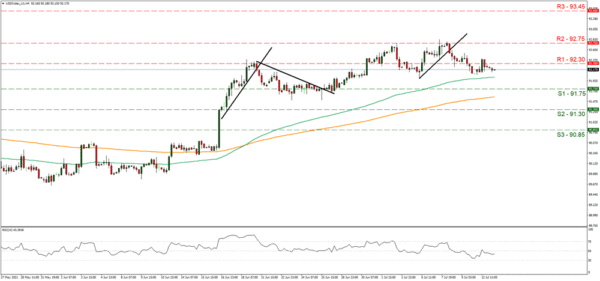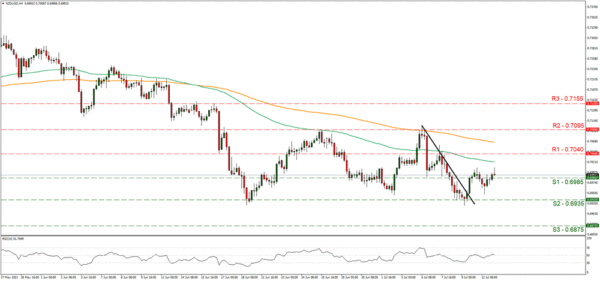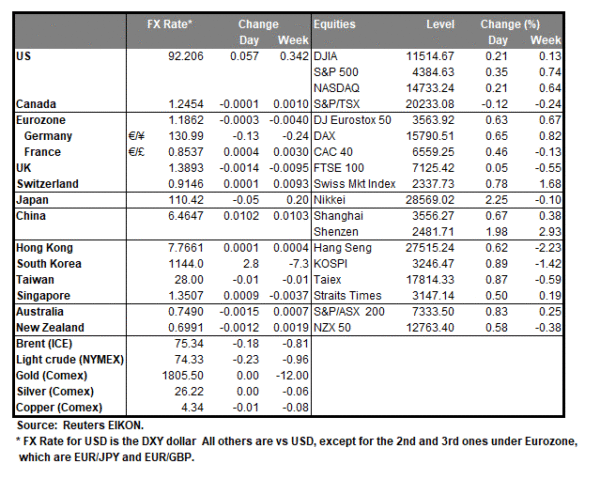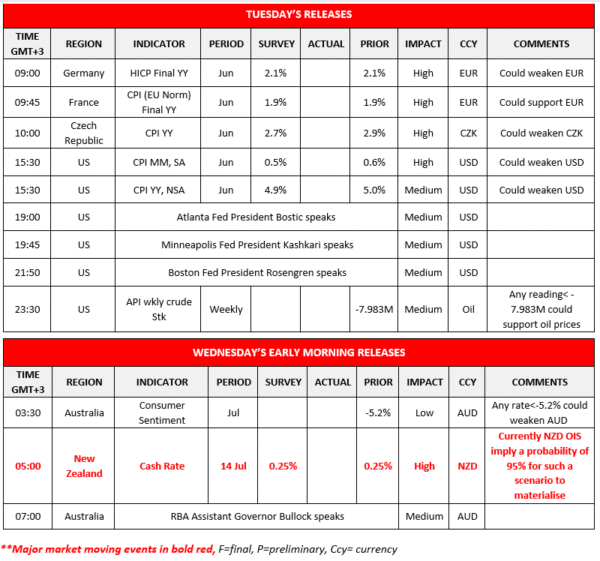The greenback tended to edge higher against some of its counterparts yesterday amidst low volatility as market attention today turns to the release of the US inflation rates for July, as the headline rate is expected to slow down after reaching an almost 13 year high on a year on year level in May. Overall, should the actual rates differ from market expectations we may see the market reacting in an effort to reposition itself. Another earnings seasons for the US stockmarkets is upon us, hence we may see some of the market’s attention turning in that direction, lowering volatility for the forex market, and today we note the earnings releases of Goldman Sachs, JP Morgan as well as PepsiCo. On the monetary front we have a number of Fed officials which are scheduled to speak, while attention turns to Powel’s testimony tomorrow.
Despite an outbreak to the upside, the USD Index remained below the 92.30 (R1) resistance line yesterday and during today’s Asian session. We tend to maintain a bias for a sideways motion, yet we note that the RSI indicator below our 4-hour chart, is lower than the reading of 50 which may imply a slight advantage for the bears. Should the bears actually take over we may see the index breaking the 91.75 (S1) support line and aim for the 91.30 (S2) level. Should the bulls prevail, we may see index breaking the 92.30 (R1) resistance line and start aiming for the 92.75 (R2) level, which also notes the highest level in our chart which was reached on the 6th of July.
Is RBNZ hawkish enough?
During Wednesday’s Asian session we get from New Zealand RBNZ’s interest rate decision. The bank is widely expected to remain on hold at 0.25% and currently NZD OIS imply a probability of 95% for such a scenario to materialize. The bank is expected to express some confidence in its accompanying letter may even foreshadow the tapering of its QE program. Also, another scenario which is heavily being discussed among analysts is whether the bank will be proceeding with its first post pandemic rate hike in November this year.
Overall, we tend to see the risks related to the release as tilted to upside for the Kiwi, unless the bank fails to meet the market’s rather hawkish expectations, in which case we may see the Kiwi asymmetrically weakening.
NZD/USD seems to have stabilised around the 0.6985 (S1) support line, after correcting higher and given that the pair’s price action has broken the downward trendline guiding it. We tend to maintain a bias for a sideways motion currently yet RBNZ’s interest rate decision as well as the release if the US inflation rates for June, could affect the pair’s direction. Should buyers be in control of the pair’s direction, we may see it breaking the 0.7040 (R1) resistance line and aim for the 0.7095 (R2) level. Should the market display a selling interest for the pair, we may see it breaking the 0.6985 (S1) support line and aim for the 0.6935 (S2) level which was able to reverse the pair’s downward motion twice since mid-June.
Other economic highlights today and the following Asian session:
Today we note the release of Germany’s and France’s final HICP rates for June as well as the Czech Republic’s CPI rate for June. In the American session we get from the US the CPI rates for June and just before the Asian session starts we get the API weekly crude oil inventories figure. During Wednesday’s Asian session, before RBNZ’s interest rate decision, we get from Australia the consumer sentiment for July. As for speakers we note in today’s American session, Atlanta Fed President Bostic, Minneapolis Fed President Kashkari, Boston Fed President Rosengren which are scheduled to speak, while during Wednesday’s Asian session we get RBA Assistant Governor Bullock is also scheduled to speak.
Support: 90.75 (S1), 91.30 (S2), 90.85 (S3)
Resistance: 92.30 (R1), 92.75 (R2), 93.45 (R3)
Support: 0.6985 (S1), 0.6935 (S2), 0.6875 (S3)
Resistance: 0.7040 (R1), 0.7095 (R2), 0.7155 (R3)



















